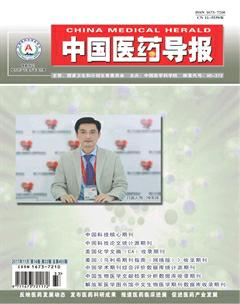中国中西部城市医院急性心肌梗死住院患者2001、2006、2011年β受体阻滞剂早期使用变化趋势
张丽华++张海波+白雪珂++霍西茜++刘佳敏+蒋立新
[摘要] 目的 評价2001~2011年中国中西部城市医院急性心肌梗死(AMI)早期(入院24 h内)适宜服用β受体阻滞剂的住院患者中β受体阻滞剂的应用趋势并探讨其使用影响因素。 方法 本研究利用两阶段抽样方法,首先采用简单随机抽样方法确定中西部城市地区协作医院,然后根据研究要求,选取2001、2006、2011年住院病历,利用系统随机抽样方法,确定研究病历,进行中心性数据提取。利用加权计算方法评估中西部城市医院总体情况。采用Logistic回归模型分析影响β受体阻滞剂使用的因素。 结果 705例β受体阻滞剂早期使用绝对适宜人群纳入研究。2001、2006、2011年,β受体阻滞剂在入院24 h内的使用率分别为55.5%、74.6%和62.6%(趋势P值=0.5927)。入院时有胸部不适症状(OR值为2.22,95% CI:1.21~4.08)的患者更倾向于早期服用β受体阻滞剂。 结论 我国中西部城市地区医院,入院后24 h内适宜使用β受体阻滞剂的AMI患者中,2001~2011年整体使用显著不足,且无改善趋势,亟需采取措施,加强医生对指南的理解及依从性,改善患者预后。
[关键词] β受体阻滞剂;急性心肌梗死;趋势
[中图分类号] R542.22 [文献标识码] A [文章编号] 1673-7210(2017)11(c)-0069-05
Early beta-blocker use in acute myocardial infarction in Central-Western Urban China in 2001, 2006, 2011
ZHANG Lihua ZHANG Haibo BAI Xueke HUO Xiqian LIU Jiamin JIANG Lixin
China Oxford Centre for International Health Research Cardiovascular Institute State Key Laboratory of Cardiovascular Disease National Clinical Research Center of Cardiovascular Diseases National Center for Cardiovascular Diseases Fuwai Hospital and Chinese Academy of Medical Sciences, Beijing 100037, China
[Abstract] Objective To assess trends of early beta-blocker use during hospitalization for ideal patients with acute myocardial infarction (AMI) and to analyze factors associated with not being treated in Central-Western Urban China from 2001 to 2011. Methods Two-stage random sampling design was used to create a representative sample of patients in Central-Western Urban China admitted to hospital for AMI. In the first phase, a simple random-sampling procedure was used to identify participating hospitals. In the second stage, a systematic sampling approach was applied for selecting patients admitted to each participating hospitals for AMI in 3 years (2001, 2006 and 2011). Then clinical information was obtained via central medical record abstraction for each patients. Weight calculation was used for each year to represent the overall situation. Logistic regression model was used to identify factors associated with early beta-blocker use. Results Finally 705 ideal candidates were included in study. Beta-blocker was used 55.5% in 2001, 74.6% in 2006, and 62.6% in 2011 (P=0.5927 for trend). Chest discomfort (OR=2.22,95% CI: 1.21-4.08) was found as the predictor of non-treatment. Conclusion The use of early beta-blocker therapy in Central-Western Urban China is suboptimal for ideal AMI patients who could definitely benefit from it. Patterns of use have not changed over time. It is urgent to implement strategy to improve clinician guidance adherence and quality of care for AMI.endprint
[Key words] Beta-blocker therapy; Acute myocardial infarction; Trends
我国正面临着急性心肌梗死(acute myocardial infarction,AMI)带来的沉重疾病负担[1-2],AMI患者尽早口服β受体阻滞剂,可降低死亡率[3-5],国内外指南明确推荐其在适宜人群中尽早应用[6-12]。我国中西部城市地区心血管疾病负担严重且卫生资源有限[13]。确保疗效明确且价格低廉的β受体阻滞剂的广泛应用,对于降低疾病负担有重要意义。但是,中西部城市AMI患者中β受体阻滞剂药物的使用情况及其使用影响因素有哪些,目前尚属未知。本文利用冠心病医疗结果评价和临床转化研究-回顾性急性心肌梗死研究(以下简称“China PEACE回顾性AMI研究”)数据,分析2001~2011年我院中西部城市医院AMI患者入院24 h内β受体阻滞剂使用的变化趋势和相关影响因素。
1 对象与方法
1.1 研究设计
China PEACE回顾性AMI研究的研究方案设计文章前期已发表[14]。简言之,研究选用两阶段随机抽样的方法,第一阶段,通过简单随机抽样确定中西部城市地区协作医院;第二阶段,选取2001、2006、2011年3个特定年份,在协作医院中采用系统随机抽样方法,抽取出院诊断为AMI的病历。研究采用统一定义和标准及集中式病历信息提取,以确保数据可靠性及准确率>98%[14]。China PEACE回顾性AMI研究所有协作医院伦理委员会均同意开展此项研究。本研究已在临床研究登记平台ClinicalTrials.gov中完成注册,编号为NCT01624883。
1.2 对象
本文的研究队列为在我国中西部城市医院接受住院诊治,且出院诊断为AMI的患者。从随机抽样所获得的AMI病例中排除不适宜评价β受体阻滞剂在入院24 h内使用情况的病例,包括转入、入院24 h内转出或死亡或出院,或参加COMMIT研究(因不确定使用β受体阻滞剂活性药物还是安慰剂)的患者,以及β受体阻滞剂禁忌证人群。此外,根据COMMIT研究[15]结果,排除过早使用β受体阻滞剂将导致休克风险增加的患者,包括年龄>70岁、入院收缩压<120 mmHg(1 mmHg=0.133 kPa)或入院心率>110 次/min的患者,最终获得β受体阻滞剂早期使用的理想人群。
1.3 统计学方法
采用SAS 9.2统计学软件进行数据分析,分别计算2001、2006、2011年AMI患者在入院24 h内β受体阻滞剂加權的使用率。每一个研究对象所占的抽样权重与其所在医院内抽样比例和该医院在整个中西部城市地区所占的抽样比例成反比。研究中的数据差异采用χ2检验或Wilcoxon秩和检验方法进行比较,并对2001~2011年该β受体阻滞剂早期应用变化进行趋势检验。利用Logistic回归方法分析β受体阻滞剂早期应用的影响因素,报告比值比(OR)及95%可信区间(95%CI)。所有统计推断均采用双侧检验,以P < 0.05为差异有统计学意义。
2 结果
2.1 研究流程
本研究共纳入705份病历进行分析,具体筛选流程详见图1。
2.2 研究对象特征
本研究人群平均年龄为62岁,男性患者占82.7%,接受早期β受体阻滞剂治疗的人群与未接受该治疗的人群基线特征见表1。
2.3 β受体阻滞剂使用情况
2001~2011年我国中西部城市医院AMI住院患者中,β受体阻滞剂在入院24 h内的加权使用率分别为55.5%、74.6 %和62.6%(趋势P值=0.5927)。见图2。
2.4 影响β受体阻滞剂早期应用的因素
多因素分析显示,入院有胸部不适症状者(OR值为2.22,95% CI:1.21~4.08)更倾向于接受β受体阻滞剂。
3 讨论
本研究首次利用我国中西部城市医院代表性的AMI患者样本,揭示2001~2011年中西部城市医院早期β受体阻滞剂适宜人群中使用率显著不足,且无明显增加趋势。针对本研究结果,亟需进一步采取改善措施,将有助于进一步改善预后。本研究中,中西部城市医院AMI患者中β受体阻滞剂使用率和全国平均水平相近(约为2/3)[16],且10年间无明显变化。而与2006年相比,2011年使用率反呈下降趋势。然而,与此同时,中西部城市地区医院AMI患者在新技术(如介入治疗)、费用相对较高的药物(如他汀等)的应用却有大幅增长[17-19]。因此,推测经济原因可能不是限制β受体阻滞剂类药物使用的原因,但是对于限制其使用的原因,仍值得反思,需进一步探讨。
分析早期β受体阻滞剂使用的影响因素,发现除入院时胸痛为影响β受体阻滞剂的因素,其他年龄、性别、高血压等疾病史及入院时血压、心率等特征均与院内使用β受体阻滞剂无明显关联,而研究中仍有接近40%的患者未使用该药物,提示不使用β受体阻滞剂并不与患者特定因素有关,而可能与医生诊疗观念有关,部分医生可能未能正确解读循证医学证据和指南,过渡担心药物副作用[20-21]。因此,本研究提示加强医生对于β受体阻滞的认识,将指南的推荐及循证医学证据应用于临床,仍是一项迫在眉睫的任务。
本研究存在一些不足之处。首先,本研究为回顾性研究,所有病历信息提取均依赖于医生对病历信息记录的准确性和完整性。然而,本研究采用标准中心性数据提取的方法,保证提取信息正确率>98%。第二,医生可能未在病历中记录某些患者对β受体阻滞剂存在不耐受或禁忌证,存在低估β受体阻滞剂的使用率的可能性。但是以上原因均不能解释约近40%的AMI患者未使用β受体阻滞剂。本研究采用严格排除标准,获得β受体阻滞剂使用的绝对适宜人群,但β受体阻滞剂使用率仍较低。endprint
本研究提示,2001~2011年我国中西部城市地区AMI住院患者早期β受体阻滞剂的使用率无明显提高,仍有改善空间。如何优化β受体阻滞剂在AMI患者中的应用,缩小临床实践与循证医学证据和指南推荐之间的差距,改善患者预后,仍是一项巨大挑战。
志谢
感谢中国牛津国际医学研究中心研究团队和美国Yale-New Haven Hospital Center for Outcomes Research and Evaluation在研究设计方面的合作贡献。感谢皮轶、刘佳敏、乌汉、杜雪、关文池、郑昕、郭远林、杨阳、孙颖、王思铭、李丽等参与数据采集。感谢Harlan M Krumholz,Frederick A Masoudi,John A Spertus,Yongfei Wang,Xiao Xu,Nihar R Desai,Joseph S Ross,Khurram Nasir,Zhenqiu Lin,Shuxia Li,Haiqun Lin等对于研究数据分析提出的宝贵建议。
[参考文献]
[1] Group WB. Toward a Healthy and Harmonious Life in China:Stemming the Rising Tide of Non-Communicable Diseases [EB/OL]. http://www.worldbank.org/en/news/feature/2011/07/26/toward-health-harmonious-life-china-stemming-rising-tide-of-non-communicable-diseases.
[2] 中华人民共和国卫生部.中国卫生统计年鉴[M].北京:中国协和医科大学出版社,2011.
[3] Group MTR. Metoprolol in acute myocardial infarction(miami). A randomised placebo-controlled international trial [J]. Eur Heart J,1985,6(3):199-226.
[4] ISIS I. Collaborative group. Randomized trial of intravenous atenolol among 16027 cases of suspect acute myocardial infarction [J]. Lancet,1986,2(8498):57-66.
[5] Yusuf S,Wittes J,Friedman L. Overview of results of randomized clinical trials in heart disease:I. Treatments following myocardial infarction [J]. JAMA,1988,260(14):2088-2093.
[6] Ryan TJ,Antman EM,Brooks NH,et al. 1999 update:ACC/AHA guidelines for the management of patients with acute myocardial infarction. A report of the American College of Cardiology/American Heart Association Task Force on Practice Guidelines(Committee on Management of Acute Myocardial Infarction)[J]. J Am Coll Cardiol,1999,34(3):890-911.
[7] Anderson JL,Adams CD,Antman EM,et al. ACC/AHA 2007 guidelines for the management of patients with unstable angina/non-st-elevation myocardial infarction:A report of the american college of cardiology/american heart association task force on practice guidelines(writing committee to revise the 2002 guidelines for the management of patients with unstable angina/non-st-elevation myocardial infarction):Developed in collaboration with the american college of emergency physicians,the society for cardiovascular angiography and interventions,and the society of thoracic surgeons:Endorsed by the american association of cardiovascular and pulmonary rehabilitation and the society for academic emergency medicine [J]. Circulation,2007,116(7):e148-e304.
[8] 中華医学会心血管病学分会,中华心血管病杂志编辑委员会.不稳定性心绞痛和非ST段抬高心肌梗死诊断与治疗指南[J].中华心血管病杂志,2007,35(4):295-304.endprint
[9] Antman EM,Hand M,Armstrong PW,et al. 2007 focused update of the ACC/AHA 2004 guidelines for the management of patients with st-elevation myocardial infarction:A report of the american college of cardiology/american heart association task force on practice guidelines:Developed in collaboration with the canadian cardiovascular society endorsed by the american academy of family physicians:2007 writing group to review new evidence and update the acc/aha 2004 guidelines for the management of patients with st-elevation myocardial infarction,writing on behalf of the 2004 writing committee [J]. Circulation,2008,117(2):296-329.
[10] Van de Werf F,Bax J,Betriu A,et al. Management of acute myocardial infarction in patients presenting with persistent ST-segment elevation:the Task Force on the Management of ST-Segment Elevation Acute Myocardial Infarction of the European Society of Cardiology [J].Eur Heart J,2008,29:2909-2945.
[11] 中華医学会心血管病学分会,中华心血管病杂志编辑委员会.急性ST段抬高型心肌梗死诊断和治疗指南[J].中华心血管病杂志,2010,38(8):675-690.
[12] Members WC,O'Gara PT,Kushner FG,et al. 2013 ACCF/AHA guideline for the management of st-elevation myocardial infarction:a report of the American College of Cardiology Foundation/American Heart Association Task Force on Practice Guidelines [J]. Circulation,2013,127(4):e362-425.
[13] 中华人民共和国国家统计局.2009中国统计年鉴[M].北京:中国统计出版社,2009.
[14] Dharmarajan K,Li J,Li X,et al. The China patient-centered evaluative assessment of cardiac events (China peace) retrospective study of acute myocardial infarction:Study design [J]. Circulation:Cardiovascular Quality and Outcomes,2013,6(6):732-740.
[15] Chen Z,Pan H,Chen Y,et al. Early intravenous then oral metoprolol in 45,852 patients with acute myocardial infarction:Randomised placebo-controlled trial [J]. Lancet,2005,366(9497):1622-1632.
[16] Zhang H,Masoudi FA,Li J,et al. National assessment of early beta-blocker therapy in patients with acute myocardial infarction in china,2001-2011:The china patient-centered evaluative assessment of cardiac events(peace)-retrospective ami study [J]. Am Heart J,2015,170(3):506-515.
[17] 李静,李希,胡爽,等.2001-2011年中西部城市ST段抬高型心肌梗死诊疗趋势——China PEACE回顾性急性心肌梗死研究[J].中国心血管病杂志,2016,21(3):177-183.
[18] Zhang LH,Desai NR,Li J,et al. National Quality Assessment of Early Clopidogrel Therapy in Chinese Patients With Acute Myocardial Infarction(AMI)in 2006 and 2011:Insights From the China Patient-Centered Evaluative Assessment of Cardiac Events (PEACE)-Retrospective AMI Study [J]. J Am Heart Assoc,2015,4(7):e001906.
[19] Zhang LH,Li J,Li X,et al. National Assessment of Statin Therapy in Patients Hospitalized with Acute Myocardial Infarction:Insight from China PEACE-Retrospective AMI Study,2001,2006,2011 [J]. PLoS One,2016,11(4):e0150806.
[20] 杨麟,孙向军,王淑贤.急性心肌梗死应用β-受体阻滞剂调查分析[J].中西医结合心脑血管病杂志,2009,7(7):845-846.
[21] 刘淑萍.β受体阻滞剂在急性心肌梗死中的应用[J].中国老年医学,2013,33(12):2995-2998.
(收稿日期:2017-06-13 本文编辑:程 铭)endprint

